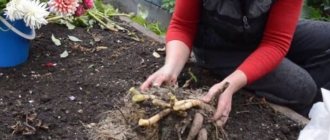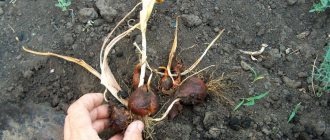Dahlia is a popular autumn flower. The shape, height, and size of the flower are different, but they have one thing in common - beauty. September warmth promotes longevity. In the absence of frost, flowering is observed even in October. Dahlias and their reproduction is a curious process that requires a comprehensive answer. Gardeners often ask how do dahlias reproduce? No less often they ask the question, how to divide dahlias? Effective propagation of dahlias by tubers.
Before dividing, we dig up planting material
If you do not plan to propagate dahlias, the bushes must be divided annually. If the plant has no more than two stems, then the flowers will be large in size. Otherwise, the size of the flowers will be smaller, their brightness and saturation will disappear. Dividing dahlias in the fall causes the bush to become younger.
If the bush is purchased at the market, it still needs to be divided. Powerful rhizomes cannot be planted. But in order to have something to divide, the plant must be dug up correctly and sent for storage before planting.
Bushes are dug up immediately after the start of frost. Someone is in no hurry to dig up the plant. After all, it is quite possible that warm weather will set in. The first frosts will only affect the new blossoming flowers. The plant itself as a whole will not suffer from them. But we must not forget that if frost strikes, the stem may be damaged and rot. We must not waste time and dig it on time. After all, rot from the stem can spread to the tuber. Therefore, any experienced gardener will say that timeliness is the determining factor in carrying out such events.
Dahlia is not gladiolus. There are no increased requirements for weather conditions. Therefore, you can dig even in rainy weather. If there are a lot of plants, then they will not all be planted. It is not necessary to dig up every single plant. It is necessary to dig up the required amount, plus a small reserve. What remains in the ground will rot and serve as good fertilizer.
Important! Two weeks before digging, stop watering the plants. This is a prerequisite for good preservation.
How to divide dahlia tubers
The choice is determined in favor of large bushes that bloom profusely. Before digging, the stems are cut to form stumps up to 30 cm high. This is protection against breaking the stems during digging. After all, this can also damage the neck of the root. The soil must be shaken off, and what remains must be washed off with water. Simultaneously with washing, small underdeveloped tubers are removed. But the main tubers that come from the neck are left behind. They will need to be divided in the spring.
If the tuber is very long, it is shortened. It is enough to leave 15 cm. If there were several trunks on the bush, divide the rhizome.
Tuber preparation
After this, the tubers are washed again with water. Another pruning is carried out, leaving a stem 1-2 cm long. During storage in winter, the material may rot. The beginning of the process is the stem. He rests on the veranda for a couple of days. In case of severe frosts, it is removed to a room inaccessible to them.
Conventional standard for dahlia divisions
A “planting unit” or standard dahlia division is one tuber with 1-3 strong, high-quality buds and well-developed, high-quality roots. Sometimes it is one “root”, and sometimes it is several, if the bud is one and only common.
In order for dahlias to develop normally, the inflorescences not to become smaller, the plant not to become depleted and to ripen normally, it is worth leaving two, or at least three, stems on each bush. It is recommended to remove excess shoots in the early stages of development, but it is better if the maximum number of shoots is limited even before germination or planting by controlling the number of buds.
It is possible to deviate from this standard or norm. In each specific case, the method of division, the lines along which to cut the rhizomes and how many buds and tubers should be left must be determined individually. It is always better to start with a thorough examination and identification of those buds that are on each rhizome. If it’s difficult to navigate, you can mark the lines and buds with a marker.
If you bought a rare variety, you have only one division, the plant did not overwinter well and there is only one tuber with a pair of buds left, we are talking about saving the variety or trying to grow a couple of bushes from one root, you can divide the root tuber in half, leaving 1- 2 kidneys. If the tuber forms strong roots and only one bud, you can safely separate it to grow a strong bush with one stem.
Tuber division
Everything must be done carefully. To do this, the stem is loosened. It may be necessary to cut the mother element.
How to properly divide a dahlia tuber?
Many people ask when to divide dahlias, in spring or autumn? In fact, you can do this in any of these periods.
Autumn division
Anyone who does this in the fall must clearly understand how to divide dahlia tubers in the fall. These manipulations should be carried out using a sharpened cutting tool. It is acceptable to use a knife or scissors.
How to do division
- Using a sharp knife, split the remaining part of the stem into two parts. In this case, the growth bud should be located on both sides. Everything must be done as carefully as possible and not allow the stem to be torn off from the rhizome. In principle, it won’t be a big deal if something like this does happen.
- The rhizome stretches to the sides. After this, the seed is inspected. If there are many kidneys, then the procedure is repeated. In a similar way, one large root can be divided into several parts. From them a new plant will be formed.
- The ideal planting material is a whole tuber or part of it with a bud. If there are two kidneys, then the cut is repeated on the cutting board. In this case, you must use a sharp knife. The given algorithm of actions is the answer to the question of how to divide dahlias in the fall.
Spring division
Gardeners do not have a common opinion regarding the time of separation. Some believe that autumn is the best time for such an event. Others have a different opinion. In winter, as a result of natural selection, the buds are well marked. Therefore, it is better to carry out the division in the spring, they believe. If this is done in the spring, then 3 weeks before planting, the material is removed from the storage location and inspected. If the buds are alive and have recovered from hibernation, the tubers are divided. The buds may be invisible as a result of the tubers drying out. They need to be sprinkled with water and left for a while to germinate. Then they are separated.
An experienced gardener knows how to divide the dahlia root for planting. The florist receives more planting material.
Separation dates for garden dahlias
It is necessary to divide dahlias, rejuvenating them and leaving root tubers of the optimal size, while they are out of the soil - before or after storage. The choice between autumn and spring division should be made depending on convenience, habits or capabilities, weather conditions in the fall during digging, and even the conditions in which the rhizomes are stored.
Each of the two separation options has its own advantages and disadvantages:
Autumn division of dahlias
It is considered the simplest and most productive way. In the fall, when the rhizomes are dug up, they still have to be cleaned, treated with fungicides, inspected, and damaged parts removed. Therefore, the cuttings that are already clean and ready to go into storage can only be divided so that in the spring you can immediately begin preparing for planting.
The main advantages of this method are the lower risk of infection by viruses and diseases, and the simplicity of the process itself. But the risks are also great:
- smaller divisions tolerate wintering outside the soil less well;
- higher risk of drying out or disease.
Spring division of dahlias
It is carried out before the awakening of rhizomes, before the start of the gardening season. Overwintered dahlias are re-inspected and discarded. In the spring, you can assess their real condition; by the end of March (and with proper storage, this is when the dormant period ends) the buds stand out well, they are easy to detect and evaluate.
The percentage of loss of planting material is less, and the size and quality of the cuttings is easier to determine. Large dahlias are stored better, so many people prefer dividing them before preparing for planting rather than after digging them up. True, the difficulty of separation, the hardness and flaccidity of the peel, and the greater risk that infection will spread to a large nest are not always offset by the advantages.
Whatever separation option is chosen, it should be remembered that careful work and thorough inspections, lack of haste are the key to success in both cases.
Autumn division of dahlia rhizomes. © uneruta
Propagation of dahlias by cuttings
Cuttings are an effective method of propagation. For this, grown young plants are used. It is better to do this in a greenhouse, but it can also be done in a cold greenhouse. Its own root system is formed. When favorable conditions are created, continuous development occurs. Rooted cuttings are planted shallowly. When placing seedlings in a pot, planting is carried out deeper. The lump descends 7 cm below the soil surface.
Using unsuitable material is associated with failure. You can't take cuttings too early. The early date for most varieties is late February, early March. At this time, it is transferred to a warm room. If there is no need for a large number of plants, this can be done in April.
Dividing the bush into parts is mandatory. The shoot appears from below, and it is very problematic to obtain a cutting of the required quality from it. It is better to work with short cuttings.
Digging up dahlias in the fall correctly
Autumn is the time of lush flowering of dahlias. They look especially luxurious in elegant decoration in September-October. They stand in all their grandeur against the backdrop of an empty area. The hand does not always rise to destroy such beauty. Therefore, when digging, you need to do the right thing, accurately guess the time.
To neither dig them up, nor sooner, nor later. Since it is in the fall that buds with future shoots are laid. They must have time to mature enough. Therefore, let them stay in the ground longer. If they are well formed and strong, they will overwinter well. Only well-ripened material can be stored.
Preparing dahlias for digging
Experienced flower growers know how poorly dahlias are stored in winter. This is perhaps their weakest point when growing. Fine varieties have thin tubers. Properly digging and preserving them in winter is a whole science.
Changeability and unpredictability of weather conditions has become the most common phenomenon in our regions. Frosts in early autumn, and even at the end of August on the soil, no longer surprise anyone.
They are not dangerous for dahlia bushes, especially if the latter are covered with spunbond. You can admire the flowers until the first frost, which will affect the lush inflorescences. But this is not a problem if you cook the dahlias at a low temperature.
Care must be taken in advance to ensure that frost does not damage the flowers. What can you do for this:
- To speed up the ripening of buds, remove the leaves from below;
- Hill up the plants to a height of 10 cm.
Well-planted perennials are not afraid of the first frosts, which are dangerous for the root collar area. Damaged by frost, they are poorly preserved and rot in the first half of winter. If frost has affected the bushes, do not despair. Take pruners and carefully trim the damaged areas. And then quite soon, new shoots may still appear there.
We dig up on time, what you need to know about the timing
Experienced flower growers advise digging up dahlias in early October. The best time is the first ten days of the month. This is exactly what you need to try to do, despite the autumn changes in the weather and the rarity of dry, cloudless days.
If the frost was severe enough to significantly damage the stems, use a shovel. Severe frost may cause the shoots with buds to turn black, but the tubers are still fine. Your task is to dig them up in 3 days.
This will save the root collar from rotting due to the excess supply of juice from frozen shoots and leaves.
Frozen dahlias need to be dug up within the specified period and here's why. As soon as the temperature rises back, the flowers' compensatory mechanism will work. Their kidneys will quickly begin to awaken. If the flowers are not dug up, they will instantly develop new shoots. This growth will greatly weaken the dahlias in winter. And they will no longer be able to tolerate long-term storage well.
We carry out pruning
The stems should be trimmed before digging. It's better to do this in advance. Usually 4-5 days before harvesting. At the same time, replacement buds peck, which subsequently facilitates the division process. First, the shoots are cut off. Then they are untied and the support is pulled out.
It is important to remember that if you untie the stems first, they may break off. The area of the cervix where the future kidneys are hidden will be damaged. And then such tubers can only be thrown away. You need to trim so that the level of the shoots above the ground is 10 cm. This is the most convenient length for further processing of root tubers.
Be sure to attach a tag indicating the variety. Place bayonets next to the flower.
We dig
You need to dig it out very carefully. Trying not to damage the neck. A shovel is the best assistant when digging up plant tubers. Even if you cut the root, there is no need to worry about it. This will not harm the dahlias. On the contrary, it will benefit them. But you absolutely cannot use pitchforks.
They will lead to numerous damage to the tubers, significantly deteriorating their quality. Under no circumstances should you pull the plant by the stem; it is better to dig deeper with a shovel. The stems break easily, but they will still be needed. Tubers dig up from all sides, moving in a circle. It is better to start at a distance of 30 cm from the plant. They are taken out along with a lump of earth.
Under no circumstances should you take it for a stump. This will damage it and the tubers will quickly rot.
What to do if it rains while digging
Excess water can damage the plants and they will begin to rot. To prevent water from getting into the stems, they must be covered. The sections can be covered with foil to prevent moisture from getting there.
You can put on plastic bags with rubber bands, thus closing the open holes. To prevent the tubers from being so fragile, you can leave them in the sun for several hours. Then you should carefully clear the soil.
Turn cut sides down and allow excess juice and water to drain from the hollow shoots.
Washing
After digging, the next hygiene procedure is a shower. The tubers need to be washed thoroughly under a strong stream of water. It is better to use a hose for this.
This way you can better wash even the most hard-to-reach places. This is where pathogenic fungi and microbes can hide. Thin conductive roots are trimmed. Old root tubers are also removed.
Be sure to label them with tags indicating the varieties.
Disinfection
To prevent diseases, experts advise carrying out a disinfection procedure. It will help get rid of pathogens such as fungi and harmful microorganisms. To do this, use a dark pink solution of potassium permanganate. The tubers are kept in liquid for 30 minutes.
A good product is “Fundazol”. The solution is prepared at the following rate: 30 g of the drug per 10 liters of water. The tubers are lowered for 20 minutes. They are then dried again with the stems facing down. If the weather remains warm, drying can be continued for up to 7-10 days.
To do this, the tubers are laid out in one layer.
Sampling
The next mandatory step is keeping the tubers for 5 days in strictly defined conditions. The room should have high humidity and at the same time low temperature. But not below zero. Frosts should not be allowed during this period.
Don't know which place to choose? Pay attention to basements, storage rooms, greenhouses that are empty by autumn, and verandas. To avoid frost, use a thermometer. This way you can control the process of airing the tubers. At the same time, the spunbond should be prepared.
Why do we need this troublesome step, which takes only a week? If everything is done correctly, a special process will begin at the roots. This is suberization of the skin. It is the durable top layer that will help dahlias be stored for a long time without spoiling. The main thing is that the plants are not infected with dangerous pathogens.
This plug protects against excessive evaporation of moisture during a long winter. And before planting, the tubers arrive plump and tight, and not dried out and twisted.
Storage
To preserve dahlias until spring, professionals recommend two effective methods.
Storing undivided tuber
After preliminary preparation, the cleanly washed and suberized dahlia is ready for long-term storage. To do this, it is placed in a bag with vermiculite. They tie it at the top with a string and put it away.
Instead of a bag, you can wrap the roots in parchment. The place where the dahlia will spend the winter should be dry and cool. The basement is suitable for this, with the exception of freezing in particularly severe frosts.
You can use a caisson.
If vermiculite cannot be obtained, peat can be its substitute. However, tubers stored in sphagnum moss are inferior in quality to those placed in vermiculite. The storage temperature should be kept at the same level. Its optimal values are 5-7 degrees.
It is difficult to create such conditions in an apartment. Therefore, if you are seriously planning to start growing dahlias, you should consider the issue of possible storage location. Higher temperatures will dry out the tubers. They will completely lose moisture, turning into mummies.
There can be no question of using them in future planting.
On the eve of spring, usually the last week of February, it is time to remember dahlias. They are taken out and transferred to a bright, warm room. The apartment is just perfect for this. Now you can begin to germinate and take cuttings. The permissible percentage of waste with this storage method does not exceed 10%.
Storing dahlias in paraffin
Washed and corked tubers are brought into a warm room in advance. The optimal temperature is 15 degrees. Within one day they are warmed up and dried. This is necessary for the buds to swell slightly.
Then they are better visible when dividing tubers and the likelihood of damaging them is reduced. Flower buds are located in the zone of the bud ring. In some varieties, at the base of the stem and even higher. When dividing, it is important that each piece has one well-developed bud.
Beginning gardeners can divide all the tubers in a proven, convenient way - into four parts. The sections are dried.
Now comes the fun part - the paraffin treatment. If dahlias are your passion, then getting a lot of paraffin will not be difficult. It can always be purchased at a candle factory with large-scale storage volumes if dahlias are grown for sale. A smaller quantity can be purchased at any pharmacy, since paraffin applications are a widely known method of treatment.
To melt paraffin, you will need a saucepan with thick double walls and a long handle. Remember that it is forbidden to heat paraffin on a gas stove. This is a flammable substance. You can only use an electric stove.
The paraffin is thoroughly heated. First, one half of the tuber is dipped into a substance heated to 70 degrees. Making sure that the paraffin evenly covers the entire skin. Then turn it over and lower the second half into the solution.
The process is very similar to cooking fruit in chocolate.
Now the paraffin tubers are ready for long-term winter storage. They are carefully placed in a cardboard box and stored in a cool room. Paraffin prevents moisture loss from tubers.
By the time they land, they look like new. Your main task now is to provide the plant with the coolest place with a temperature of 5-6 degrees. Since flowers will respond to higher temperatures by starting to grow.
And this will greatly disrupt storage and weaken them until spring.
Source: https://ogorodnikam.com/sadovye-rasteniya/kogda-i-kak-vykapyvat-georginy-osenyu/
Propagation of dahlias by tubers
The tubers should migrate to a warm room in March. A sufficient amount of light is required. Here they are germinated. Before this, remove everything that has been damaged. For ten minutes, the planting material is dipped in a weak solution of potassium permanganate (0.2%). Then it is planted in boxes and sprinkled with sandy soil. The root collar is open, the soil is moist. After 10 days they divide. For this purpose, the root tuber is cut into pieces. Each contains at least one eye. When planting, the cut remains free of backfill.











